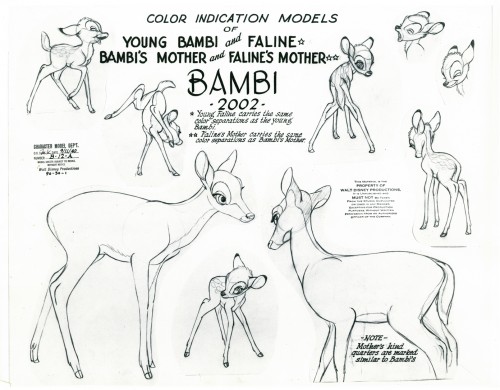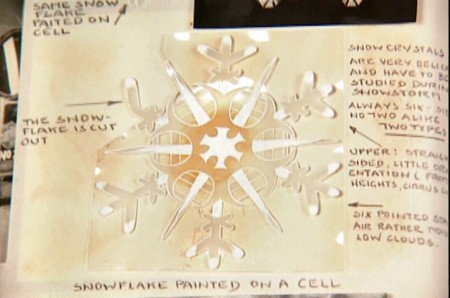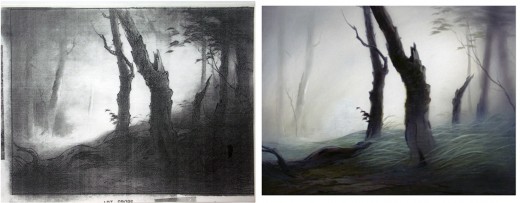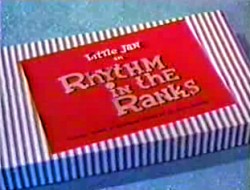Search ResultsFor "bambi"
Animation &Art Art &Norshtein 17 Feb 2010 09:20 am
Norshtein & The Overcoat
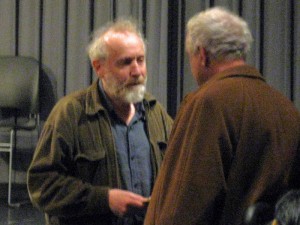 - I was pretty proud of the New York animation community. There was a full turnout for the Yurij Norshtein show on Monday night. All of the key people one hoped would show up, did show up. I was surprised at the many familiar faces in attendance: Amid Amidi, Richard O’Connor, John Dilworth, John Canemaker, Emily Hubley, the Rauch brothers, the Kraus brothers, Biljana Labovic, Jeremiah Dickey, Howard Beckerman, Matt Clinton, David Levy . . . the list goes on.
- I was pretty proud of the New York animation community. There was a full turnout for the Yurij Norshtein show on Monday night. All of the key people one hoped would show up, did show up. I was surprised at the many familiar faces in attendance: Amid Amidi, Richard O’Connor, John Dilworth, John Canemaker, Emily Hubley, the Rauch brothers, the Kraus brothers, Biljana Labovic, Jeremiah Dickey, Howard Beckerman, Matt Clinton, David Levy . . . the list goes on.
Norshtein and Reeves Lehman, dean of animation at SVA
And it was appropriate for him to
have a good turnout. Norshtein is the height of “Art” in animation, and he’s a beacon for us all. If ever one gave everything to the creation and forward movement of the artform, this guy is it. He’s been working on his film adaptation of Gogol’s The Overcoat for the past 25 years or so. He screened roughly 13 minutes of the film broken into two parts. Both were screened in silent B&W.
The first part was the opening 10 mins of the film. Throngs of shoppers and passersby in the snow on a crowded Moscow street. All I could think of was the enormous number of cutout parts for all these people, just to assemble one image of the film. Yet they were animated and the sequence was long. One guy did all the construction of those characters, all the animation, all the movement. How in hell did he keep each of those many people and parts of people in his head so that he knew how they moved? No computer assistance to help, only his brain. And to top it off the camera, with all those planes, is moving as well. It’s an extraordinary feat.
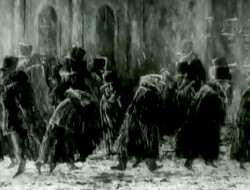
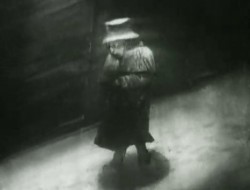
Then the lead character enters and we see what he sees – not the crowds but the writing in his head. He’s a lowly scrivener, a copyist; someone who spends his day copying documents. Obviously, he can’t remove the work and the words from his mind, though the world he walks in is filled with distraction.
From these street scenes he goes home to an extended sequence of warming himself up and eating a small bowl of soup. The character motion and development is all open to us in this incredible scene wherein we enter the tiny physical, introverted world of this man.
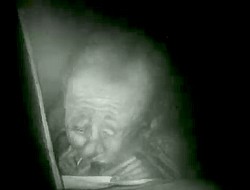
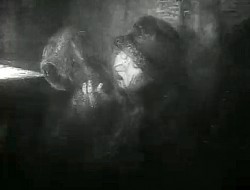
The final three minutes show him realizing how worn his overcoat has become. Threadbare doesn’t begin to describe it as his fingers easily poke through the fabric again, and again. When he puts the coat over his head, fibers end up in his mouth.
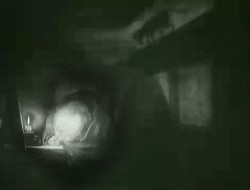
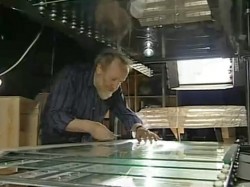
A long, very long display of character. All B&W and silent. It’s going to be another masterpiece from this brilliant artist. All done by hand by him on a complex and large camera set up. One person controlling all the pieces.
 The Heron and the Crane and Hedgehog in the Fog were screened from the Jove dvd. Most of the evening was Norshtein answering questions. (There was a bit of an onstage struggle between two interpreters, during the opening segments, with the stronger interpreter doing duty for most of the event.) He took the dumbest of questions and turned them into answers we always wanted to hear. A question from a young girl about what his favorite animated films turned into a list of expected films that I was not surprised to hear: Night on Bald Mountain Disney, Crac Back, There Once Was a Dog Nazarov, and he admitted that it’s a list that’s constantly changing. He also spoke of recently watching a print of Bambi frame-by-frame on an editing machine. He said it was a film that has enormous beauty in every frame, in it’s backgrounds and layout, as well as in its whole as a film.
The Heron and the Crane and Hedgehog in the Fog were screened from the Jove dvd. Most of the evening was Norshtein answering questions. (There was a bit of an onstage struggle between two interpreters, during the opening segments, with the stronger interpreter doing duty for most of the event.) He took the dumbest of questions and turned them into answers we always wanted to hear. A question from a young girl about what his favorite animated films turned into a list of expected films that I was not surprised to hear: Night on Bald Mountain Disney, Crac Back, There Once Was a Dog Nazarov, and he admitted that it’s a list that’s constantly changing. He also spoke of recently watching a print of Bambi frame-by-frame on an editing machine. He said it was a film that has enormous beauty in every frame, in it’s backgrounds and layout, as well as in its whole as a film.
During his answering questions he spoke articulately to us about everything from animation to great painters to great authors. I have to say that I can’t remember any other ASIFA meeting where the “young” Michelangelo or Velazquez were discussed, nevermind Chekhov and Proust. In the past week, I’ve attended a number of Oscar parties – one for James Cameron, one for Quentin Tarantino, one for Sandra Bullock. If there’s a celebrity in New York, I’ve had a chance to meet them. I’d trade them all for that evening with Norshtein at that little SVA theater.
After the screening, they were selling photo prints in the lobby, signed by Norshtein. I bought two hoping in some small way to support him on this trip. They also serve as souvenir reminders to me that I have to be more of an artist in my own work.
(As always, click any image you’d like to enlarge.)
You can read more details by Dayna Gonzalez about the event at the ASIFAEast newsletter.
And Richard O’Connor offers a collection of notes and quotes from the evening to his blog for Asterisk Animation.
Commentary &T.Hachtman 28 Nov 2009 08:51 am
Fox/List/Gert
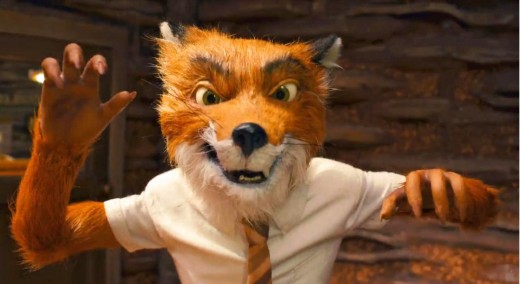
The Fantastic Mr. Fox – Did I tell you often enough that I really like this movie? One director – one voice. Independent spirit. Relatively low budget – $40 million. See it for fun.
- There’s a solid interview with Wes Anderson on the always enjoyable Onion’s AV CLub. His comments are worth reading, expecially if you’ve seen the film.
- Rotten Tomatoes, on the arrival of Disney’s The Princess and the Frog, has created a listing of Disney animated features and organized them into a list of titles. The order of the list is determined by some shaky criteria. Per Rotten Tomatoes: We used a weighted formula that takes into account the Tomatometer, number of reviews, and release year of every film included. We excluded all Disney subsidiaries and companies through which Disney has distribution deals hence, no films from Pixar, Studio Ghibli, or DisneyToon Studios are on the list.
Here’s their listing. Each title is followed by the Tomatometer rating:
- 1. Pinocchio 100%
2. Snow White 98%
3. Fantasia (1940) 98%
4. 101 Dalmatians 97%
5. Dumbo 97%
6. Beauty & the Beast 93%
7. Lion King 92%
8. Aladdin 92%
9. Cinderella 92%
10. Sleeping Beauty 91%
11. The Little Mermaid 90%
12. Bambi 89%
13. The Jungle Book 89%
14. Bolt 88%
15. Tarzan 88%
16. Lady and the Tramp 87%
17. Mulan 86%
18. Emperor’s New Groove 85%
19. Lilo and Stitch 85%
20. The Rescuers 84%
21. Fantasia 2000 82%
22. Hercules 83%
23. Peter Pan 83%
24. Alice In Wonderland 81%
25. The Hunchback of Notre Dame 72%
26. The Sword in the Stone 73%
27. Treasure Planet 70%
28. Meet the Robinsons 66%
29. Dinosaur 65%
30. The Aristocats 65%
31. The 3 Caballeros 87%
32. The Fox and the Hound 71%
33. Pocahontas 56%
34. Home on the Range 55%
35. Robin Hood. 55%
36. The Black Cauldron 58%
37. Atlantis: the Lost Continent 46%
38. Oliver and Company 44%
39. The Adventures of Ichabod & Mr. Toad 89%
40. The Rescuers Down Under 60%
41. The Many Adventures of Winnie the Pooh 91%
42. The Great Mouse Detective 79%
43. Brother Bear 38%
44. Chciken Little 36%
45. Saludos Amigos 70%
46. Melody Time 88%
47. Make Mine Music 67%
48. Fun and Fancy Free 67%
Just to amuse myself, I sought out all the Don Bluth films and compared their Tomatometer ratings to see which would be hightest. No surprises, except maybe that American Tale was rated so low. These aren’t graded the same way the Disney films were, above. Some of Bluth’s films weren’t rated:
- The Secret of NIMH 94%
Anastasia 85%
An American Tale 63%
Titan AE 51%
All Dogs Go to Heaven 44%
The Pebble and the Penguin 36%
Thumbelina 25%
Rock-A-Doodle 20%
Continuing the process let’s look at Ralph Bakshi‘s films. He didn’t fare as well as Bluth; some of Bakshi’s films weren’t reviewed either:
- Heavy Traffic 88%
American Pop 56%
Fritz the Cat 53%
Wizards 53%
The Lord of the Rings 47%
Cool World 6%
- After posting Tom Hachtman’s Renaissance Masters the past four weeks, I’m sort of out of sorts to not have any more of it. Let me post a couple of Gertrude & Alice cartoons to fill the void:
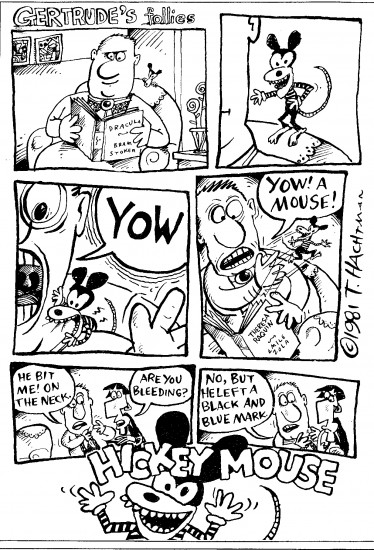
This one could be a comment on the “Twilight” experience.
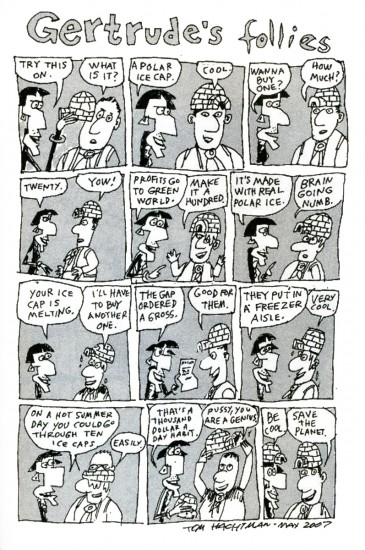
This week I heard about the after-show auction going on
at A Steady Rain‘s Broadway performances. Hugh Jackman &
Daniel Craig are raising cash for Broadway Cares by having
after-show auctions of their “sweaty” T-shirts.
Gert & Alice can do it for the environment.
And while I’m at it, let me post one of my favorite strips (which I’d posted once before.)
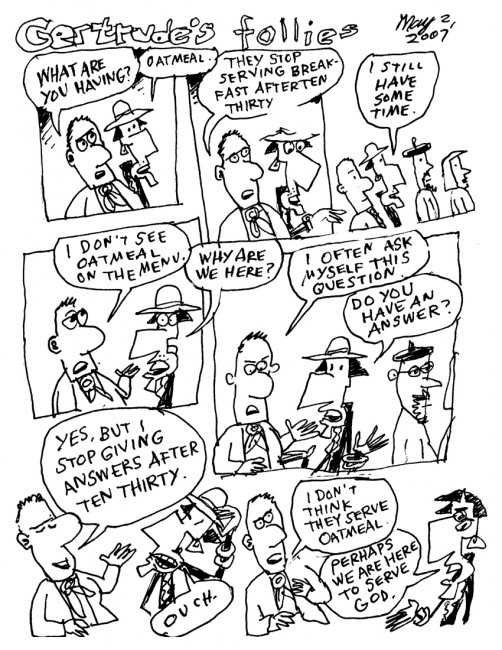
(Click any image to enlarge.)
Animation &Bill Peckmann &Disney &Models &Story & Storyboards 28 Sep 2009 07:36 am
Bambi Board 2
- The cache of stats that Bill Peckmann recently sent me on loan includes several photo pages of storyboard from the Bambi Twitterpated sequence. I’m not much of a fan of this sequence, but looking at these beautiful storyboard drawings makes me realize how charming it is in its original state. The cute/cartoony movements came from the animators and directors. Perhaps the film needed this funny, broad approach, but I have a feeling there are other ways it could have been tackled that might have let it feel more connected to the whole.
As with past board postings, I’ve cut them up into rows so that I can post them at a higher res for better viewing. First here are the three pages as they stand:
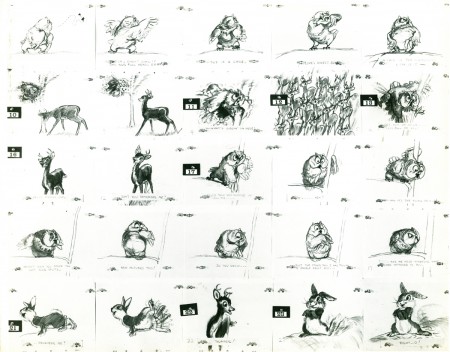 1
1(Click any image to enlarge.)
Now here they are again broken into individual rows:
 1a
1a
Here are some model sheets which relate to this sequence:
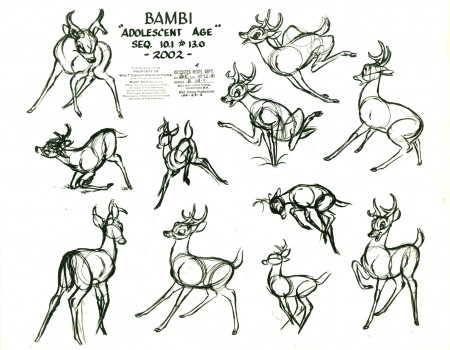 1
1
Once again, many thanks to Bill Peckmann for the loan of this marvelous material. It’s truly appreciated, and it’s fun to share.
It’s amazing to think how Walt Disney pushed all this great art forward. This film actually moved the “Art” side of animation forward with the majestic backgrounds, realistically designed animation and bold storytelling approach. There’s no possibility that something as rich as this film could be done today.
Animation Artifacts &Bill Peckmann &Disney &Models &Story & Storyboards 21 Sep 2009 07:34 am
Bambi Board 1
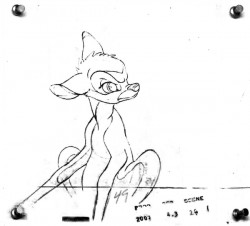 - Straight from the collection and the kindness of Bill Peckmann comes these three photo captures of a presentation board from Bambi.
- Straight from the collection and the kindness of Bill Peckmann comes these three photo captures of a presentation board from Bambi.
One of the photos is missing, consequently on the first picture every other group of four panels is gone. If you look at photos #3 & #4, you’ll see that they should be read across. The top 4 images from #3 should be followed by the top 4 images from #4; then onto the second row.
The same should be true of photos #1 & #2, but #2 is missing. What’s here is so good, though, that I’m posting it just the same.
As with past boards, I post the boards/photos as they came to me. Then I break them up (putting them into proper order) a row at a time. This is to be able to offer you the highest res copy of all.
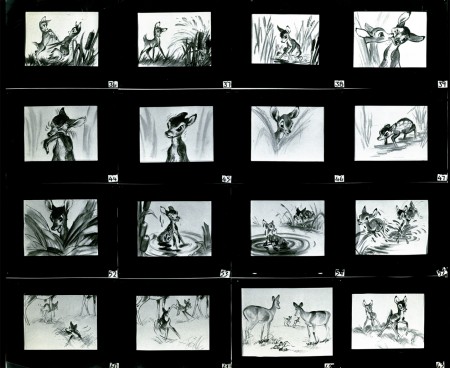 1
1(Click any image to enlarge.)
And now the breakdown of these three boards:
missing four panels
missing four panels
missing four panels
Photo 3 & 4 combined
Here are some model sheets that relate to this material:
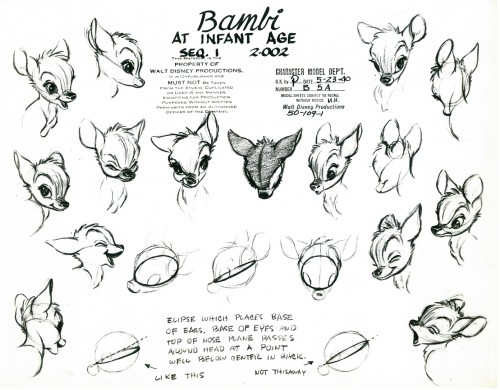 1
1
If you’re interested you should check out past posts on Rico LeBrun’s animal anatomy lessons: Part 1, Part 2, Part 3
There are another three pages of storyboard that I’ll post soon. Again, many thanks to Bill Peckmann.
Animation &Disney &Frame Grabs 09 Sep 2009 07:43 am
Fantasia FX
- Herman Schultheis was an effects animator who worked on Fantasia. He kept a tight record of the effects they were creating from 1938-1941 and a photo display of how they were done. Schultheis disappeared in 1954 while trekking through Central America, and the notebook was forgotten until his wife’s death in the early 1990s, after which it was discovered by Howard Lowery behind the couple’s bedroom wall.
The book will be on display at the The Walt Disney Family Museum when it opens in October. It’s also been digitized so that visitors will be able to go through the book, enlarge photos and view it page by page.
Prior to the discovery of the book we were able to figure out a few of the effects. One Disneyland show, in fact, recreated the bubbling lava scene from the Rite of Spring sequence.
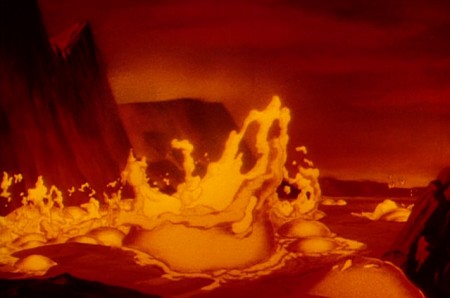
(Click any image to enlarge.)
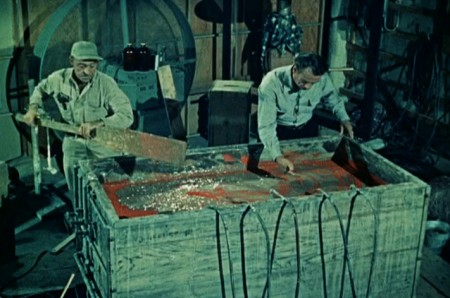
Josh Meador recreated the slow motion shoot of the
boiling concoction used to develop the bubbling lava.
However, the book revealed so much more than we’d understood
about how the superb effects had been crafted.
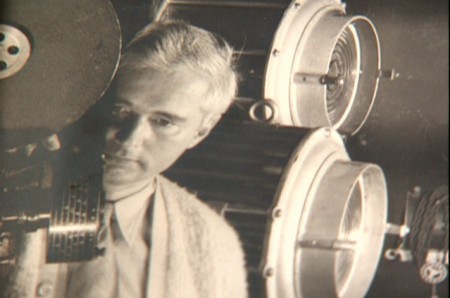
Herman Schultheis created the book of charts and photos
which gives us a link to the many creative effects in the film.
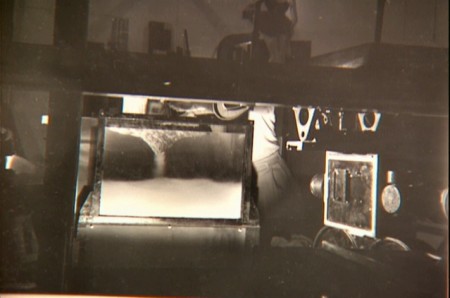
Using a vat of water, they were able to
drop ink into the liquid and film it in slow motion.
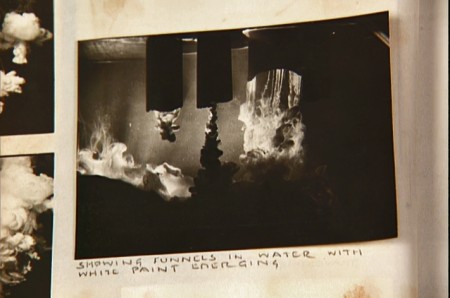
A photo of the ink spilling into the water behind built-in mattes.
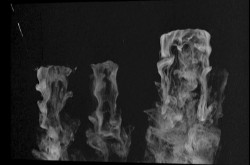
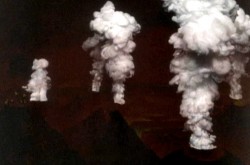
Taking the shot of the ink, they then turned it upside-down.
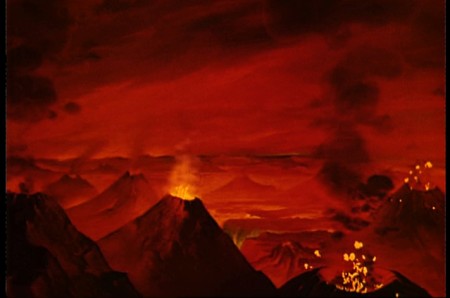
They then superimpose the “smoke” (or ink) over the volcanoes.
This same effect was used in Close Encounters of the Third Kind
to create clouds when the alien ships were moving in on the
farmhouse where the boy and mother lived.
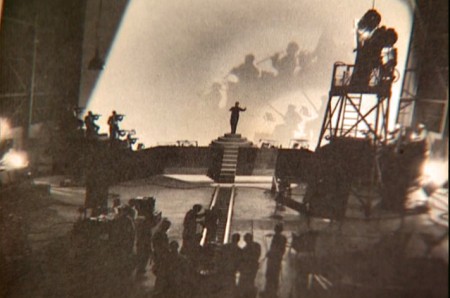
The orchestra was shot on a set with strong, planned shadows.
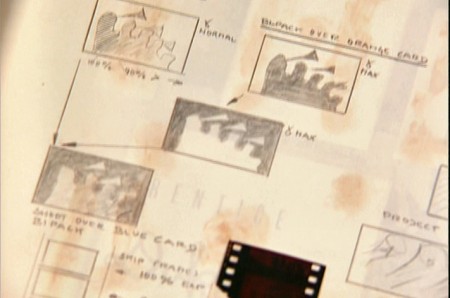
All these shots were orchestrated and planned for color effects.
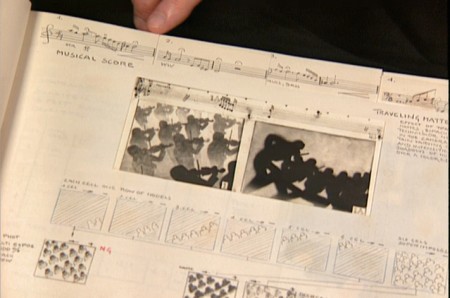
They were also catalogued by Schultheis who kept close
track of the music, as well, in his book. You can see a
page by page breakdown of the score at the top of the page.
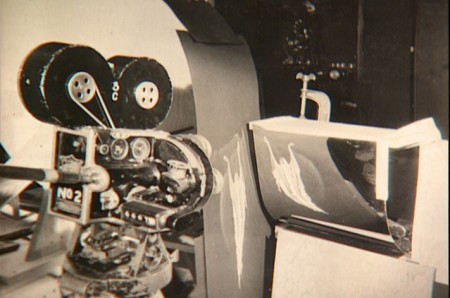
You can see the highly polished sheet of metal (middle left) which reflected
and distorted the animation drawings. This is what the camera photographed
in some of the scenes during the Night on Bald Mountain sequence.
It was also used for the fire in Bambi.
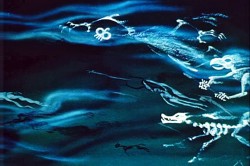 1
1 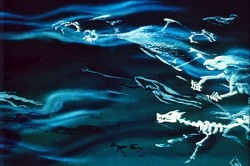 2
2
This scene’s ghosts were shot using that distorted metal reflection.
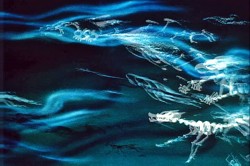 2a
2a 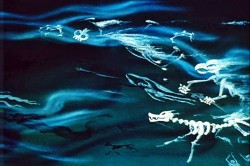 3
3
The ghosts also used a form of cross dissolve.
John Hubley explained to me how that was done.
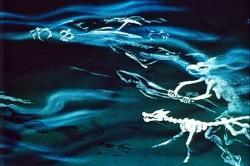 4
4 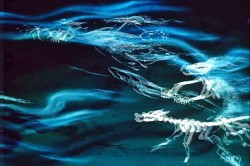 4a
4a
They shot the entire scene at 50% exposure. Then they went back
to the beginning and reshot the entire scene again at 50% exposure.
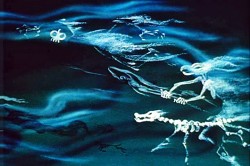 5
5 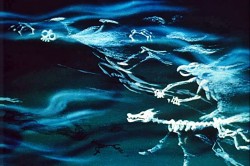 6
6
However on the second shoot, they started by shooting a black frame.
This made #1 fall where #2 should have been, #2 for #3 etc.
This creates a ghostly dissolve effect.
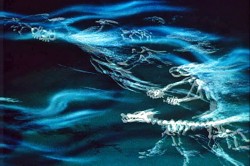 6a
6a 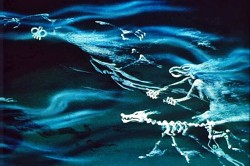 7
7
All of the drawings labelled with an “a” are the double exposures:
2a, 4a, 6a
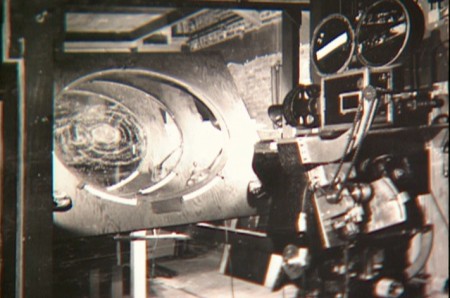
A make-shift circular multiplane camera was built.
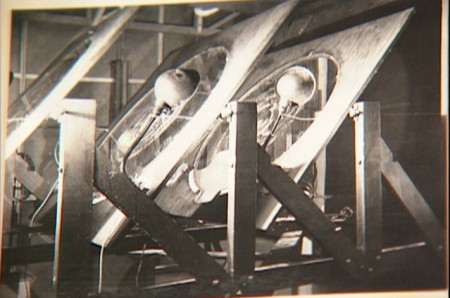
Created out of wooden sheets with holes cut out,
placed so they could shift angles, they were designed to
allow revolving artwork in the circular cut outs.
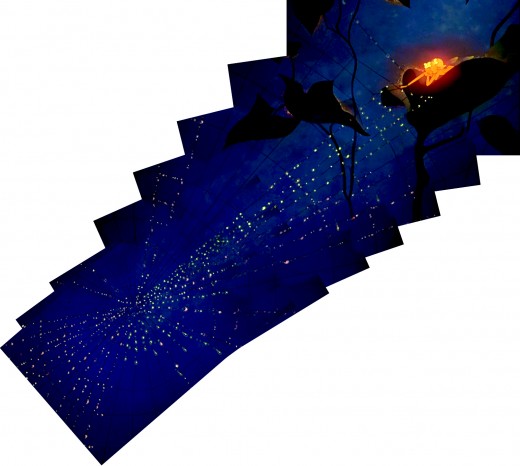
This allowed shooting scenes such as this shot of
a spider web as the camera turned around it while
dew glistened off it.
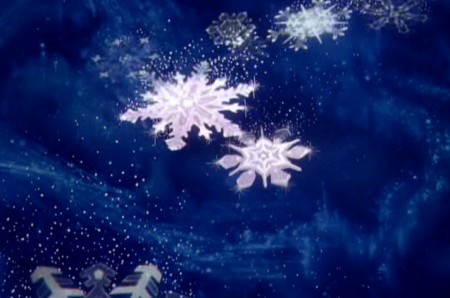
The spinning snowflakes are well explained in Schultheis’ book.
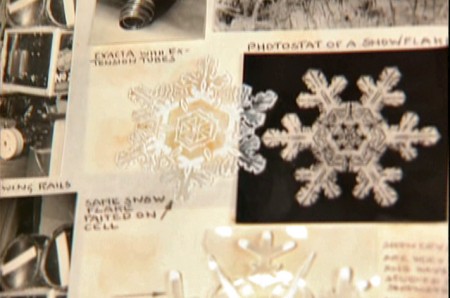
The snowflakes had a detailed construction.
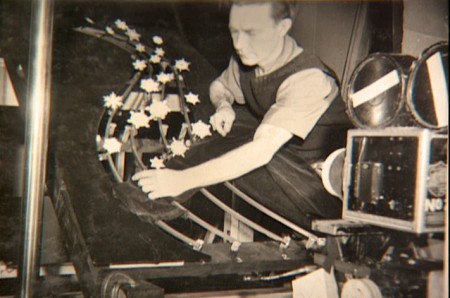
The path of action was intricately defined.
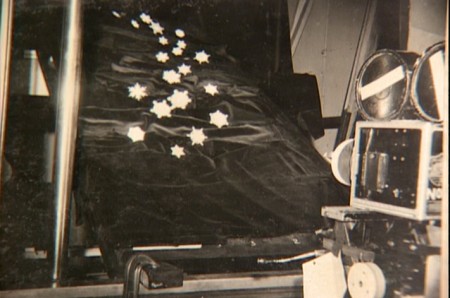
The snowflakes were shot against a sheet of black velvet
hiding the wire guides.
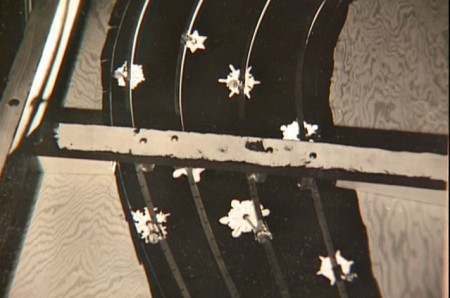
They were shot in tight closeup. From below you can
see the turning gears they were constructed on.
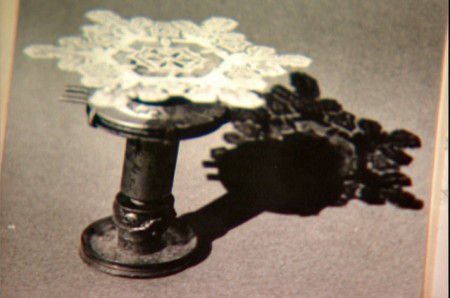
Each snowflake was built on a turning gear
so that they could revolve in their path of action.
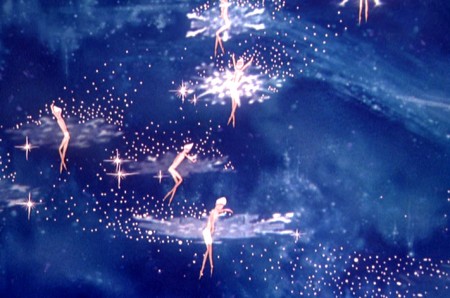
Burn these snowflakes over the multiplane background
and add matching 2D animated fairies within each snowflake,
and you have the finished scene.
Commentary 01 Jun 2009 07:31 am
Up
Everyone’s giving a review of Up, so how can I resist after promising as much last week.
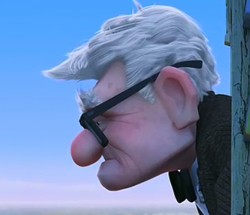 - I have to hand it to Pete Docter and Pixar; UP is a very good film. However, there are challenges for this viewer.
- I have to hand it to Pete Docter and Pixar; UP is a very good film. However, there are challenges for this viewer.
The first ten minutes are nicely flawless and set up the story well. Then, after Carl is widowed, the film settles down to earth and gets a bit mundane. Once Carl goes to court, the film shifts, turning into a cartoon and losing its lyricism increasingly as the film moves on. More and more, the imaginiative and unlikely ideas are thrown at us, and the story becomes less and less believable.
There’s a nice, expedient and acceptable way for Docter to cut short the flight and get them to their South American desitination. It’s smart, but it left a big, “Huh?” for me before I moved on. That’s when the dogs enter wearing their jokey voice collars. I wonder if it might have been better for them to keep the dogs without voices. That would probably have offered fewer gags but a bit more logic.
Michael Giacchino‘s score is excellent. The main themes sound a bit like music from a Doris Day film. Light, bubbly and “50s”. It brings the airiness the film tries hard to maintain.
There are several refernces to King Kong (the 1933 version). It occurs when they’re entering a terrain that seems a bit remniscent of the native village in Kong. Lots of repetitive drums right out of Max Steiner’s original score. The most obvious reference, of course, is those dogs in bi-planes trying to shoot down Russell. A couple of the jungle terrains also seem to be pulled from the earlier film.
But then, the film includes dozens of references to other live action films: the opening seems right out of Citizen Kane, the villain is named Charles Muntz (sounds like Mintz) and looks like Kirk Douglas, Carl looks like Spencer Tracey. There are many more, but I’m not sure if they’re there for any purpose other than “fun”.
There’s some animation in the film that’s quite fine , but there’s also some not-so-good animation there. Lots of slipping and sliding in walk cycles; lots of weightless characters (an old cgi bugaboo.) However, it’s miles above most of what I’ve recently seen and does give me a bit of hope.
Up‘s credibililty, for me, roams far from reality with a number of points including: a super humongous zeppelin (where do they get the petrol to run this thing?), talking voiceboxes on the dog collars (not only is the villain a great adventurer, he’s also a brilliant inventor able to read dog-thoughts and build this eccentric machinery in the wild), dogs flying bi-planes with dart-shooting machine guns, and many other bits of business just turn the film into a not-very-believable cartoon.
Of course, all this is a byproduct of the principal idea – a house being lifted by hundreds of balloons. It’s certainly impossible, but we all came into the theater knowing this to be a basic premise, and we agreed to accept it before sitting down. However, I’m not sure we were buying into a lot of other cartoony ideas after sitting through that excellent opening that ultimately seems to be from a different film. It’s as though Bambi had Bugs Bunny as a friend, not Thumper, and the film kept trying to squeeze them together for us.
I’d hoped to accept the entire premise as a conceptual metaphor. Though, I don’t think Docter, in his unspooling of the story, allows us to take this approach to the imaginative but cartoony ideas, so I had to ride with it at face value.
Perhaps this is all irrelevant to most viewers; the film is quite enjoyable while watching it. I did find myself stepping in and out of the story as it progressed, thanks to lapses in credible moments. I also found the film a bit tiresome at about the 2/3 point. Like Wall-E when they’re chasing around in space, inside and outside the spaceship, this film has a dangerous chase inside and outside a zeppelin, on and off the balloon house. They came to the precipice at least four times too many and escaped every time.
I’m glad for what they gave me in this film, but I guess I’m the curmudgeon who hopes the “Action” scenes will be a tad more plausible in screen stories. And I guess I also wish for a little less “Action” in those films. All that running about over and over again get tedious.
But make no mistake, I do think UP is a very good film . . . just not the great one it might have been.
By the way, you have to check out Lou Romano‘s site which is filled with brilliant pre-production art for this film.
Books &Disney &Mary Blair 14 Apr 2009 08:16 am
Chouinard the Book
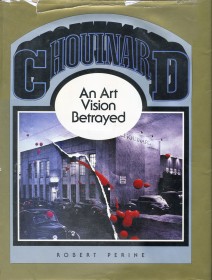 - I recently came upon an excellent book, Chouinard/An Art Vision Betrayed by Robert Perine published in 1986. This book is the history of the school that would become CalArts.
- I recently came upon an excellent book, Chouinard/An Art Vision Betrayed by Robert Perine published in 1986. This book is the history of the school that would become CalArts.
I suspect it’s more familiar to those on the West Coast than we on the other side of the continent. Regardless, the book well documents the connection between this art school and the Disney studio, particularly in the early days.
Here we’re treated to a good history of Don Graham, who led the Disney classes for Walt during the ’30s expansion movement. We also come upon students and teachers including all the famous names: Phil Dike, Virgil Partch, Hardie Gramatky, Retta Scott, Mary and Lee Blair, Ward Kimball and many others. We’re also treated to photos and artwork by these people. We also see a clear picture of the school’s founder, Nelbert Chouinard.
I’ve pulled a couple of photos and art pieces and a couple of paragraphs from the first chapter which I thought worth sharing.
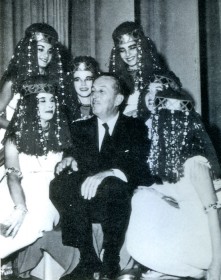 I made a deal with some of the teachers at Choulnard to come out and work with me, to sit with me by the day and know my problems. That, In turn, gave them the chance to know what we had to work on. They sat tight In the room with me; I picked Graham because he was more Life . . . figures and movement and things . . . simplification. So Graham sat with me In what we called our sweatbox. Fifty percent of my time was spent In the sweatbox going over every scene with every animator.
I made a deal with some of the teachers at Choulnard to come out and work with me, to sit with me by the day and know my problems. That, In turn, gave them the chance to know what we had to work on. They sat tight In the room with me; I picked Graham because he was more Life . . . figures and movement and things . . . simplification. So Graham sat with me In what we called our sweatbox. Fifty percent of my time was spent In the sweatbox going over every scene with every animator.
The sweatbox was an un-insulated projection room which Walt describes as “hot as the dickens,” where animators would come to sweat out Walts approval of their latest attempts. ‘They used to dread comin’ in… I’d just tear hell out of’em,” but this was all part of the learning process as both animators and studio head ____________Walt at Egyptian Ball – 1956
worked out the best solutions for making the
moving figure work. So Graham was soon a part of this process and carried Walt’s ideas back to his classroom.
Reciprocally, a bit of Graham (and Nelbert) rubbed off onto Walt as they worked together 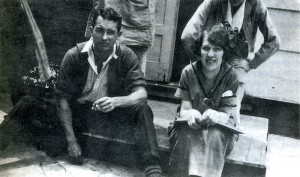 on the problems of animation. Said Walt:
on the problems of animation. Said Walt:
I set up a whole new thing (which Is) having Us effect now among the artists. We think of action. We think of drawing for action. We call It action analysis. You draw from a static figure when you’re In Life class. And your model’s sitting there. You’re draiumg the spinal column … the whole anatomy… _______Don Graham on the porch of the 8th St. School
but you don’t get any feeling of action.
So we have the model go through actions. She goes through It and then.. .sits over In the corner.. .and they sketch what they saw. What you see here (Is) not a literal copy of something. It’s.. .the Illusion you get.
Even before Walt had come to California — when he was only 19 — he had frugally photostated Muybridge’s now-famous movement photographs out of a borrowed library book, then cut them up and overlapped them in an attempt to analyze motion. But now it was a new kind of challenge — doing it with drawing. Walt further describes that challenge:
We’ve got to analyze the walk. So we would then photograph people going through actions… then we would study It. There were a lot of things I was able to get over that way. You’d have a running action. We’d draw. (It’d) be perfect because (we’d) be looking at that drawing Individually on the drawing board. (But) It doesn’t look that way; that’s what gave us stiff animation. Then we got the trick of blurting.. .In effect, elongating. When you’re moving fast Is when the action begins to take on a smoothness.. At wasn’t numbers of drawings. It’s how drawings are made.
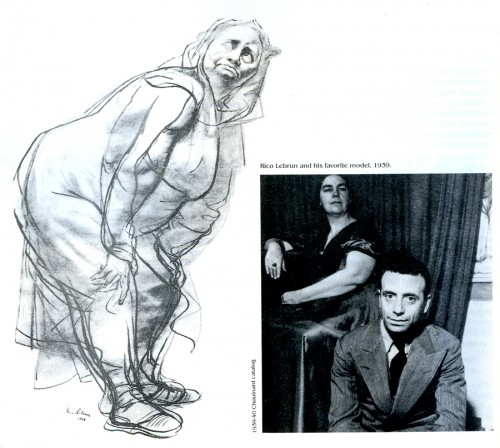
Rico LeBrun (who taught animal anatomy to the animators
at Disney during the making of Bambi) and his favorite model
-
The ideas that developed during Disney’s training period (1930-1940) were greatly aided by Don Graham. Eventually Walt hired him at Disney Studios as head of their own night school. So Nelbert’s influence and ideas were carried out into the professional world. In the animation industry alone Chouinard students and teachers like Graham, Dike, Caldwell, Davis, Gramatky, Fleury, Johnstone, Lebrun, Lee and Mary Blair, T. Hee, Plummer, and many others became important stimuli to the successful growth of the animated film.
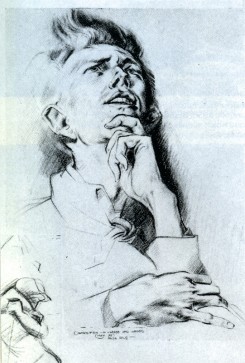
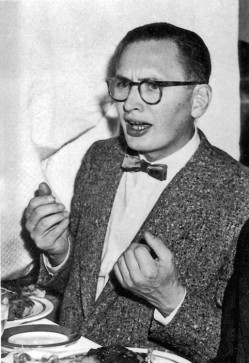
A drawing by Retta Scott | Virgil Partch at a Guild Meeting
The book is a treat. I’ll add more to this in a future post.
Commentary &Daily post 28 Mar 2009 08:17 am
Bric and Brac and Clips
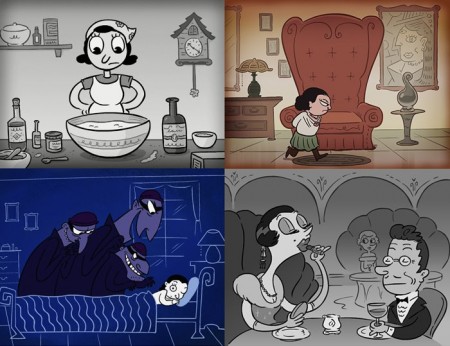
- Last Monday, PBS premiered a documentary on two women entrepreneurs — Elizabeth Arden and Helena Rubinstein. The Powder and the Glory features a number of different film clips and interviews and also several animated sequences done by Animator, Bob Flynn. He created several sequences for the film done with the help of those at Fablevision.
The program will air in New York on WNET, CHANNEL 13 today, Saturday, March 28, at 1:30pm.
You can see some of the animation here. It has a distinctive style and works well within the program. I particularly liked the sequence wherein Helena Rubenstein is robbed. The style is a bit reminiscent of James Thurber’s art.
Hans Bacher has the post of the week that excited me most. On his site, Animation Treasures, he’s taken some Background layouts for Bambi and has placed them alongside their finished Backgrounds. The comparison is amazing and deserves your attention.
How many times have we seen animation drawings compared to the finished cels? Here are some brilliant designs in execution. Hans also talks a bit about the painting of these stunning Backgrounds on glass.
By the way, if you don’t own Hans’ book Dream Worlds: Production Design for Animation, get out there an buy it or demand your local library carry it. The book is an essential for those interested in pursuing any career in animation. Or even those who have a strong interest in the medium.
- John Schnall sent a recent ad he did for Bzztrust, a business website. He asked that I post it, and it’s expectedly funny. So why not!
_________________
- Brian Sibley, on his very entertaining and informative site, has posted several excellent pieces about Alice in Wonderland. One includes a history of Snap, Crackle and Pop (there is a connection) that deserves your reading. (If anyone can identify the studio that did the British Alice commercial, please let me know.)
Brian posts a clip from a Jonathan Miller version of the story that I was not familiar with. The fact that Alan Bennett appears as the Mouse was enough for me to order the film.
Yes, that’s Peter Sellers as the king and Wilfred Brambell
(Paul’s father in A Hard Day’s Night), as the White Rabbit.
Other cast members include:
Michael Redgrave (Caterpillar), Leo McKern (Duchess),
Peter Cook (Hatter) and John Gielgud (Mock Turtle)
Articles on Animation &Disney 14 Mar 2009 08:12 am
After Walt
- Didier Ghez on his site Disney History recently posted an article about life at the Disney Studio after Walt’s death in 1966. There were quite a few such articles during this period, and we were made to hope something would happen to generate life into the animation division of a company that was turning out bad films.
Time Magazine had the following article in their Aug. 16, 1979 issue:
CORPORATIONS
Running Disney Walt’s Way
When lung cancer killed Walt Elias Disney a decade ago, there were fears that the world of Disney would lose some of its wonder—and its profits. But before his own death in 1971, Roy Disney, who succeeded his younger brother, and a cadre of post-Walt executives had turned Walt Disney Productions into a thriving empire of fantasy. Today the company is bigger and richer than ever. Profits flow in from Disney’s two successful theme parks, Disneyland in California and the magic kingdom at Walt Disney World in Florida, from film rentals and television, from re-releases of such longtime favorites as Bambi, Pi-nocchio and Fantasia, and from sales of record albums, Mickey Mouse wrist-watches and everything else bearing the Disney stamp.
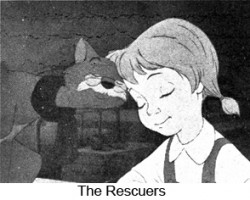 Last year the various forms of escapism earned Disney nearly $62 million on sales of $520 million—four times the total in 1966 when Walt died. For the first nine months of its current fiscal year, Disney was flying higher than Dumbo the elephant. Corporate profits were up 30%, and sales rose 16%. More than 6 million people flocked to Disneyland (which turned 21 in July), another 9 million to Disney World. The fifth re-release of the animated Snow White and the Seven Dwarfs, which came out in 1937, will gross an estimated $10 million in the U.S. alone by the end of this year.
Last year the various forms of escapism earned Disney nearly $62 million on sales of $520 million—four times the total in 1966 when Walt died. For the first nine months of its current fiscal year, Disney was flying higher than Dumbo the elephant. Corporate profits were up 30%, and sales rose 16%. More than 6 million people flocked to Disneyland (which turned 21 in July), another 9 million to Disney World. The fifth re-release of the animated Snow White and the Seven Dwarfs, which came out in 1937, will gross an estimated $10 million in the U.S. alone by the end of this year.
Analysts’ View. No one questions that Disney has come a long way since the studio gambled $1.5 million on Snow White. But Wall Street analysts insist that the company should be doing even better and are hypersensitive to any developments that could remotely be considered adverse. Last month, for example, Disney stock fell several points (to around $50, or more than 20 times earnings) because third-quarter earnings, though a record $19 million, were not up to Wall Street’s expectations. Says a Disney vice president: “That’s a source of irritation around here. They seem to run in a pack on the Street.”
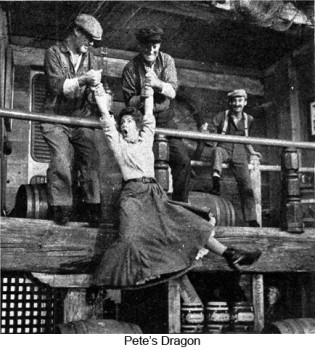 The founder’s ideas still run the show: almost everything Disney is now into was conceived of by Walt. “That’s the way Walt would want it” is a refrain heard frequently in the stucco Disney headquarters in Burbank, Calif. The executive most responsible for sticking to Walt’s winning formulas is E. Car-don Walker, 60, who joined Walt as a camera operator in the 1930s and has been Disney president since 1971. A tall, husky man whose use of profanity is limited to an occasional G-rated “damn,” Card Walker occupies an unpretentious office on the Disney lot not far from Dopey Drive and Mickey Avenue. His only concessions to the Hollywood movie mogul image are tinted glasses and a sleek gray Porsche (license plate: CAR WIN).
The founder’s ideas still run the show: almost everything Disney is now into was conceived of by Walt. “That’s the way Walt would want it” is a refrain heard frequently in the stucco Disney headquarters in Burbank, Calif. The executive most responsible for sticking to Walt’s winning formulas is E. Car-don Walker, 60, who joined Walt as a camera operator in the 1930s and has been Disney president since 1971. A tall, husky man whose use of profanity is limited to an occasional G-rated “damn,” Card Walker occupies an unpretentious office on the Disney lot not far from Dopey Drive and Mickey Avenue. His only concessions to the Hollywood movie mogul image are tinted glasses and a sleek gray Porsche (license plate: CAR WIN).
Walker believes that “the biggest challenge we face is still to make top-quality films,” and film critics tend to agree. Though slick and successful, the recent crop of Disney animated and live-action films (Gus, Treasure of Mate-cumbe, Robin Hood) shows little of Walt’s skill at tugging an audience over pop-emotional peaks and valleys. Nor do the forthcoming The Rescuers and Pete’s Dragon. Indeed, not since Mary Poppins in 1964 has Disney produced a genuinely smashing, supercalifragilisti-cexpialidocious hit.
This fact troubles Walt’s corporate heirs. Says Walker: “I don’t know exactly what it is. We don’t cut costs. Based on the quality of people involved in the film making, I would just have to say that we do our best.” Others blame excessive reverence for the traditional Disney method of moviemaking: batteries of cartoonists working under a rigid discipline on a single project for as long as three years. Says one young artist-animator who worked briefly for Disney: “The work is too confining. There’s not enough room to use your creative talents. It’s sterile.”
More and more, Disney is setting its animators to work on gutsier movies that seize audiences instead of rocking them to sleep. One feature in the storyboard stage, The Hero from Otherwhere, is about two schoolboys who find themselves on a strange planet whose black leader persuades them to help destroy a wolf that has been ravaging the land. Another, Spacecraft One, about a mile-long spaceship in its search for life on other planets, is Disney’s most elaborate sci-fi undertaking since 20,000 Leagues Under the Sea. The Black Cauldron, still in the treatment-writing stages, is about a pig keeper’s struggle with a villain whose shtick is regenerating an army of warriors from dead bodies—a long way from Poppins. Sex and excessive violence still are taboo on the Disney lot, but Walker foresees increased sophistication as younger animators reflect contemporary themes.
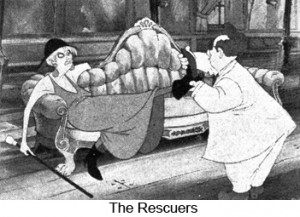 Non-film projects, however, account for three-fourths of Disney revenues and therefore generate the greatest excitement in the Disney organization. With Disneyland and Walt Disney World booming, the company is now moving on the biggest of Walt’s ideas: EPCOT, or Experimental Prototype Community of Tomorrow. To be built by the early 1980s in Florida as an expansion of Disney World, EPCOT will be a living laboratory of applied technology in transportation, housing, communications and waste disposal. Near it will rise the World Showcase, a permanent World’s Fair. Still another theme park. Oriental Disneyland, now planned to open late in 1979, will border Tokyo Bay in Japan; the Disney people expect it to draw 10 million visitors annually at the tourist hub of Asia. Estimated cost: about $175 million—most to be borne by the Japanese.
Non-film projects, however, account for three-fourths of Disney revenues and therefore generate the greatest excitement in the Disney organization. With Disneyland and Walt Disney World booming, the company is now moving on the biggest of Walt’s ideas: EPCOT, or Experimental Prototype Community of Tomorrow. To be built by the early 1980s in Florida as an expansion of Disney World, EPCOT will be a living laboratory of applied technology in transportation, housing, communications and waste disposal. Near it will rise the World Showcase, a permanent World’s Fair. Still another theme park. Oriental Disneyland, now planned to open late in 1979, will border Tokyo Bay in Japan; the Disney people expect it to draw 10 million visitors annually at the tourist hub of Asia. Estimated cost: about $175 million—most to be borne by the Japanese.
Double Duty. Whatever its problems, Disney has perfected one talent that other Hollywood fantasy factories envy: piggybacking. The familiar cartoon characters boost attendance at the theme parks, and the parks increase attendance at the movies. Though no one at Disney claims to be Walt’s equal in artistry or dreaming, Card Walker has made Disney’s characters do double duty as stars and as barkers to all the world. As a merchandising idea, it has proved to be almost as successful an inspiration as the original Mickey Mouse.
Commentary &Puppet Animation 27 Feb 2009 08:56 am
Puppets
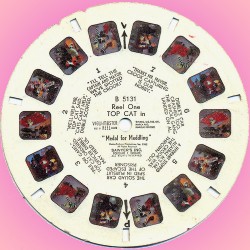 - Brian Sibley has written a quite wonderful piece on Viewmaster slides. He shows people prepping to photograph these little sets and characters for the 3D setups. It’s a chance for many of us to get a quick joyride from the past.
- Brian Sibley has written a quite wonderful piece on Viewmaster slides. He shows people prepping to photograph these little sets and characters for the 3D setups. It’s a chance for many of us to get a quick joyride from the past.
Brian’s post had me do a bit more research, and I came across Brian Butler‘s site, What My Dad Saw which has many posts on the subject and actually posts a number of the slide images recreating the 3D effect.
Likewise, this led me to Brian Hunn’s site Mystery Hoard which had a longer piece on Florence Thomas and Joe Liptak who created many of these scenes.
.
.- For those of you who’d like to see more puppets on parade, Ken Priebe sent me the link to a beautiful copy of a hard-to-see George Pal Puppetoon on YouTube. Rhythm in the Ranks.
The color on this piece, given the format, is exceptional, well preserved.
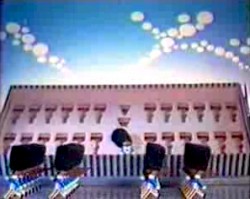 . .
. . 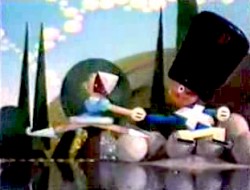
_____________
- For those of you who get excited reading new material about puppets, Wade Sampson has an excellent article about Bob Baker’s puppet productions of Walt Disney’s animated musicals. This is an entertaining read.
- I’ve yet to see Coraline, but I’ll have to get there.
I would prefer not seeing it in 3D (polarized glasses HAVE to grey/green down the image, and I’d prefer seeing actual colors on the screen, despite the 3D effect. However, I don’t believe it’s playing in Manhattan except in 3D. The film seems to be top of the craft, though I’ve read enough semi-negative about the story. I like most of the voice talent and expect that to give the animators something good to work with.
Like Tim Burton’s Corpse Bride, Coraline enhances the 3D stop-motion animation with cgi enhancement. This is a distinct advantage modern animators have. Even 2D animation isn’t solely dependent on the Pencil Tests and computerized compositing; animated 2D films are also filled with cg embellishment. And they should be. All tools are available and should be used (although I’m not sure many cg films use 2D enhancement.) I think that’s why I get such joy out of the old George Pal and Ray Harryhausen films. What they saw was what we got. If they opened the shutter, they were usually committed to that frame. It’s amazing that we still haven’t improved on Pinocchio or Bambi or, in some ways, John Henry and the Inky-Poo
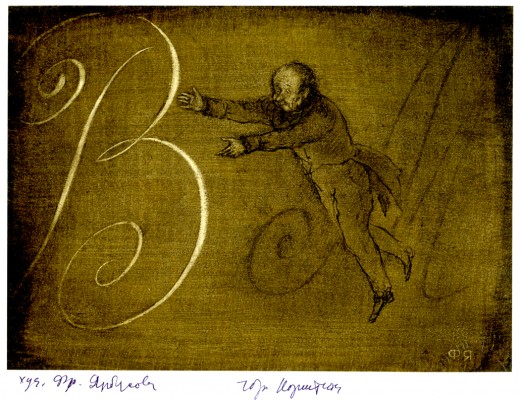
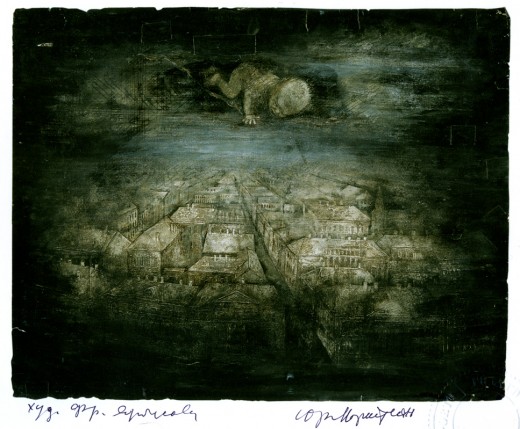
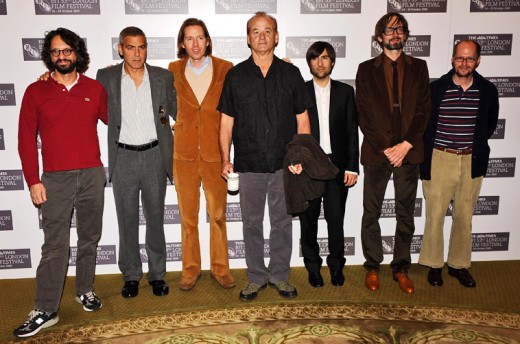
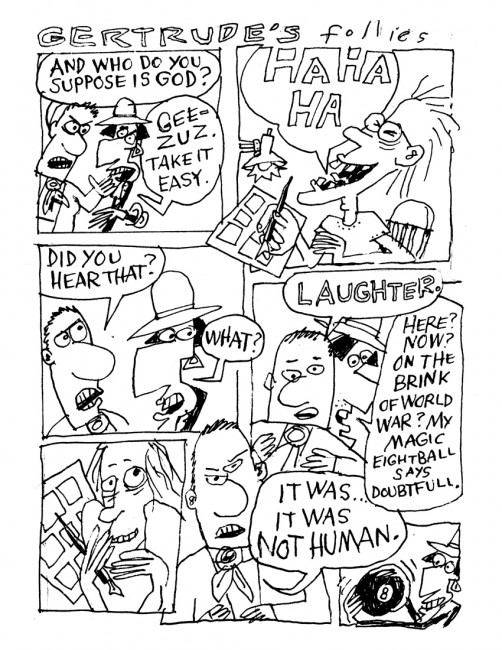
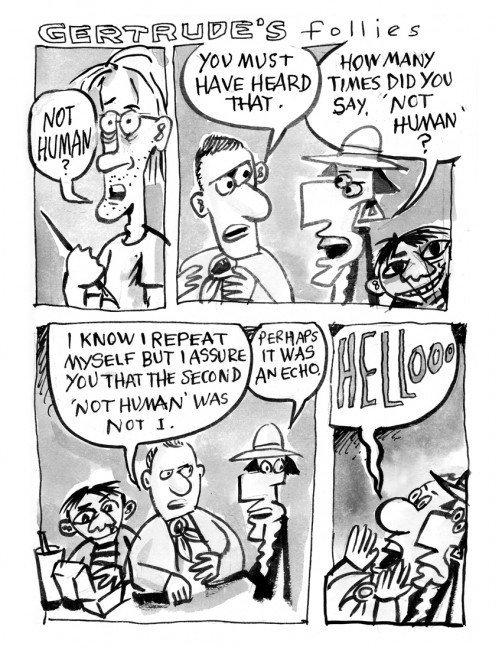
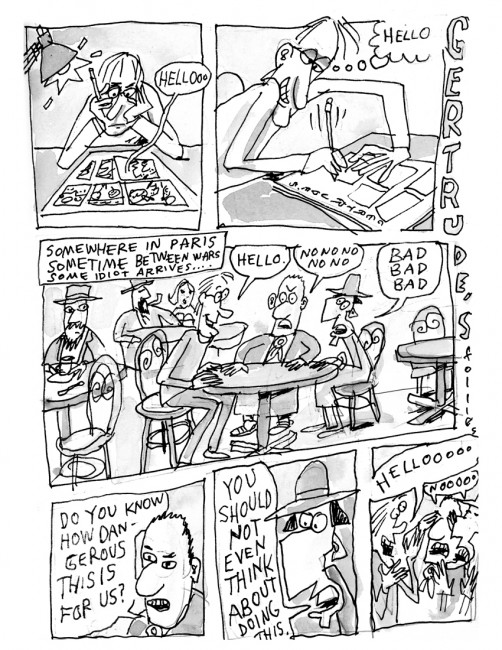
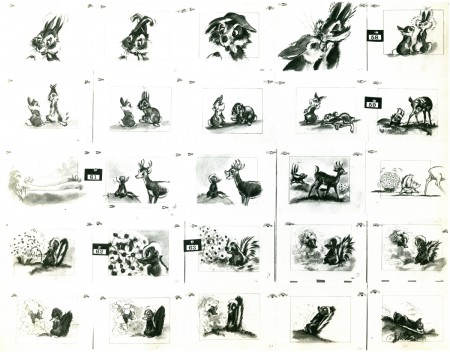
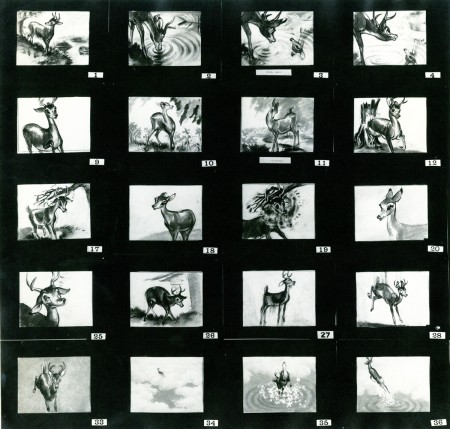














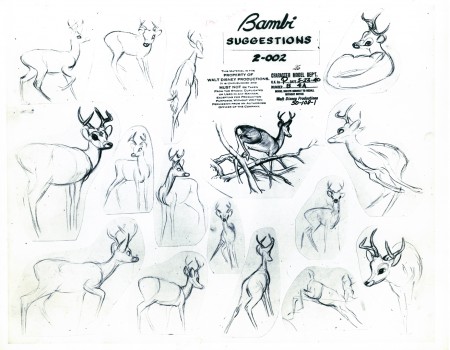
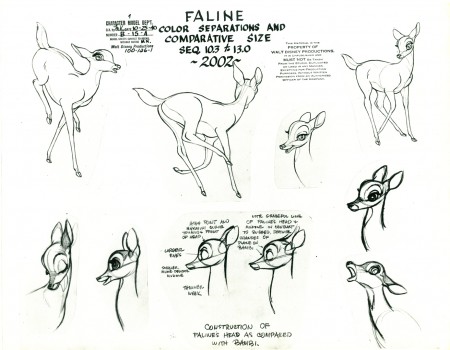
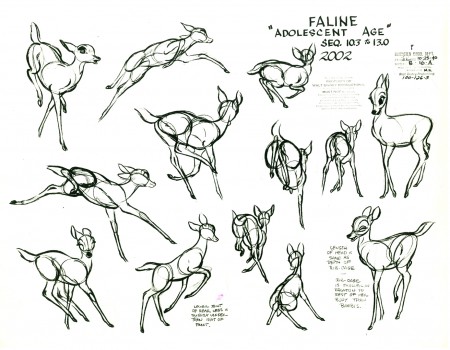
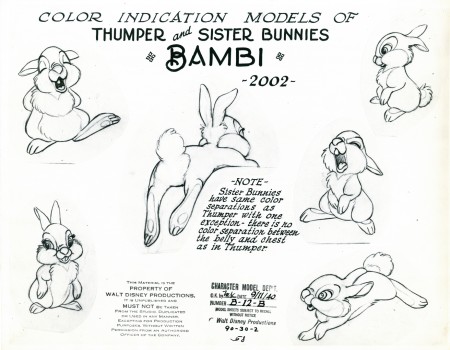
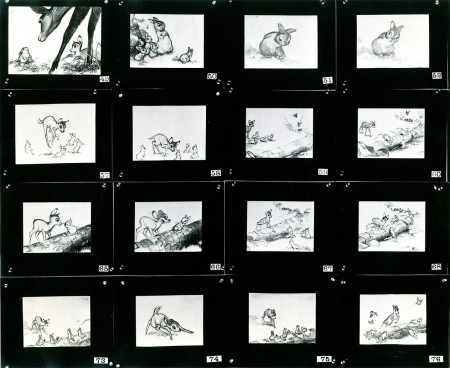
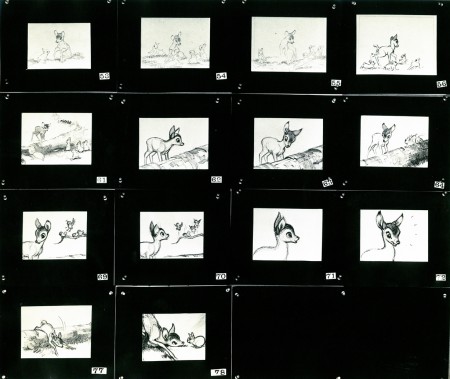










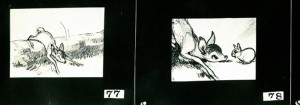
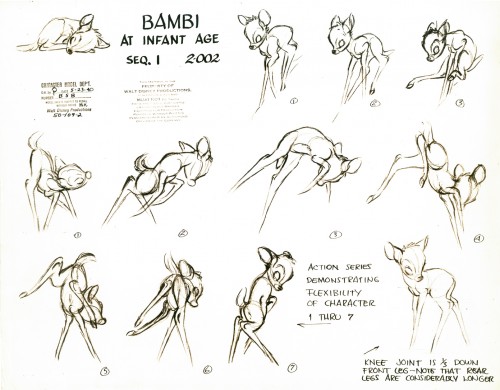 2
2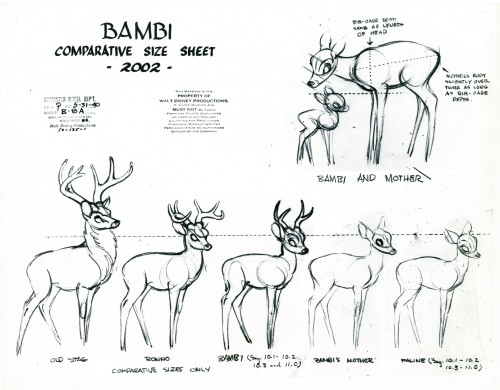 3
3